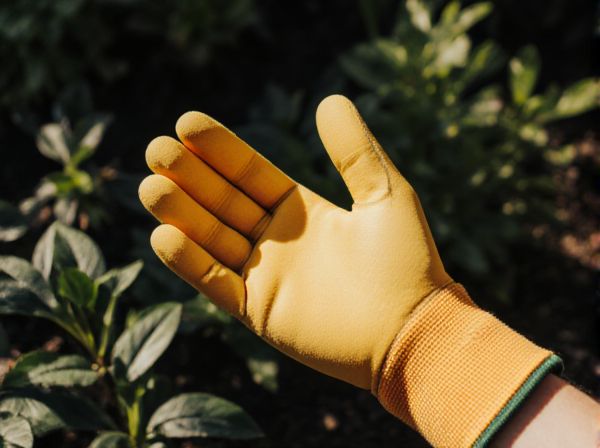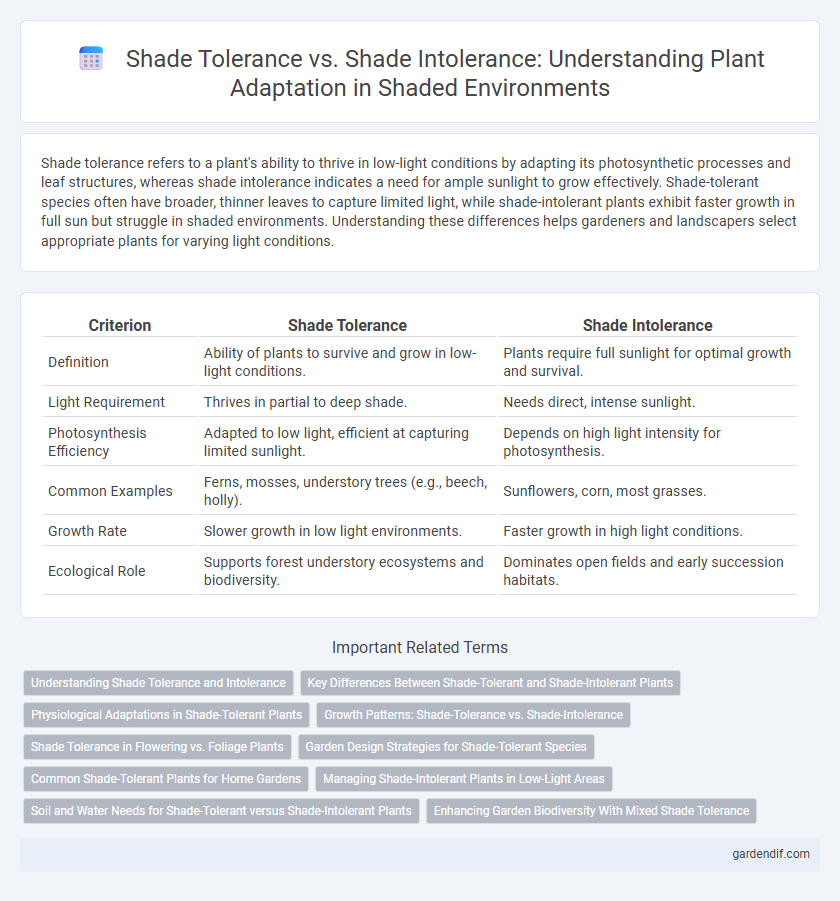
Shade tolerance vs shade intolerance Illustration
Shade tolerance refers to a plant's ability to thrive in low-light conditions by adapting its photosynthetic processes and leaf structures, whereas shade intolerance indicates a need for ample sunlight to grow effectively. Shade-tolerant species often have broader, thinner leaves to capture limited light, while shade-intolerant plants exhibit faster growth in full sun but struggle in shaded environments. Understanding these differences helps gardeners and landscapers select appropriate plants for varying light conditions.
Table of Comparison
| Criterion | Shade Tolerance | Shade Intolerance |
|---|---|---|
| Definition | Ability of plants to survive and grow in low-light conditions. | Plants require full sunlight for optimal growth and survival. |
| Light Requirement | Thrives in partial to deep shade. | Needs direct, intense sunlight. |
| Photosynthesis Efficiency | Adapted to low light, efficient at capturing limited sunlight. | Depends on high light intensity for photosynthesis. |
| Common Examples | Ferns, mosses, understory trees (e.g., beech, holly). | Sunflowers, corn, most grasses. |
| Growth Rate | Slower growth in low light environments. | Faster growth in high light conditions. |
| Ecological Role | Supports forest understory ecosystems and biodiversity. | Dominates open fields and early succession habitats. |
Understanding Shade Tolerance and Intolerance
Shade tolerance refers to a plant's ability to thrive in low-light environments by efficiently utilizing limited sunlight for photosynthesis, often characterized by larger, thinner leaves and slower growth rates. Shade intolerant species require abundant sunlight for optimal growth and typically exhibit faster growth, smaller, thicker leaves, and a higher photosynthetic capacity under full sun. Understanding the physiological and morphological differences between shade tolerant and intolerant plants is crucial for effective landscape design, forestry management, and ecological restoration.
Key Differences Between Shade-Tolerant and Shade-Intolerant Plants
Shade-tolerant plants possess adaptations like larger chloroplasts and efficient chlorophyll utilization, enabling them to perform photosynthesis effectively in low-light environments, whereas shade-intolerant plants require abundant sunlight and often exhibit stunted growth under shade. Shade-tolerant species typically have slower growth rates, broader leaves, and a higher chlorophyll content to maximize light capture, while shade-intolerant species grow rapidly with smaller, thicker leaves optimized for intense sunlight. The ecological niches differ significantly: shade-tolerant plants thrive under dense canopies in forests, whereas shade-intolerant plants dominate open areas, relying on direct sunlight for optimal metabolic function.
Physiological Adaptations in Shade-Tolerant Plants
Shade-tolerant plants exhibit physiological adaptations such as increased chlorophyll content and larger, thinner leaves to maximize light capture under low irradiance conditions. Their photosynthetic apparatus is optimized for low-light efficiency, with enhanced light-harvesting complexes and reduced photorespiration rates. Adaptations also include higher stomatal density to facilitate CO2 uptake despite limited light availability.
Growth Patterns: Shade-Tolerance vs. Shade-Intolerance
Shade-tolerant plants exhibit slower, steady growth with efficient photosynthesis at low light levels, enabling survival under dense canopy cover. Shade-intolerant species demonstrate rapid growth with a high light requirement, optimizing energy capture in open, sunlit environments. These contrasting growth patterns reflect adaptations to different light niches, influencing forest composition and understory dynamics.
Shade Tolerance in Flowering vs. Foliage Plants
Shade tolerance in flowering plants often relies on their ability to perform photosynthesis efficiently under low light conditions, with many species exhibiting larger, thinner leaves to maximize light capture. Foliage plants typically demonstrate greater shade tolerance due to their structural adaptations, such as a higher concentration of chlorophyll and broader leaf surfaces, allowing sustained growth in shaded environments. Understanding these physiological differences is crucial for selecting appropriate plants for shaded landscapes, optimizing garden design for light availability.
Garden Design Strategies for Shade-Tolerant Species
Shade-tolerant species thrive in low-light environments, making them ideal for garden design strategies that maximize greenery in shaded areas. Incorporating plants such as ferns, hostas, and astilbes enhances understory layers while maintaining aesthetic appeal and biodiversity. Effective shade garden designs also emphasize soil moisture retention and organic mulch use to support these species' growth and resilience.
Common Shade-Tolerant Plants for Home Gardens
Common shade-tolerant plants for home gardens include hostas, ferns, and astilbes, which thrive in low-light environments by adapting their photosynthesis processes. Unlike shade-intolerant plants that require full sun to grow healthily, these shade-tolerant species efficiently utilize limited sunlight and maintain vibrant foliage in shaded areas. Selecting shade-tolerant plants enhances garden aesthetics and biodiversity while ensuring successful growth under trees or shaded patio spaces.
Managing Shade-Intolerant Plants in Low-Light Areas
Shade-intolerant plants struggle to perform essential functions like photosynthesis in low-light areas, leading to poor growth and increased susceptibility to disease. Managing these plants requires selecting partial shade spots with at least 4-6 hours of indirect sunlight and improving soil quality through mulching and organic matter to boost nutrient uptake. Regular pruning and monitoring for stress symptoms also help maintain plant vigor in less-than-ideal lighting conditions.
Soil and Water Needs for Shade-Tolerant versus Shade-Intolerant Plants
Shade-tolerant plants typically require consistently moist, well-drained soils with higher organic matter to support their slower growth rates and lower photosynthetic activity under limited light. In contrast, shade-intolerant plants thrive in soils with better aeration and often need more frequent watering to sustain their rapid growth and higher water uptake in full sun conditions. Proper soil moisture management is critical for shade-tolerant species to prevent root stress, while shade-intolerant species demand optimized water availability for peak photosynthetic efficiency.
Enhancing Garden Biodiversity With Mixed Shade Tolerance
Incorporating plants with varying shade tolerance levels enhances garden biodiversity by accommodating a wider range of light conditions and supporting diverse ecological niches. Shade-tolerant species thrive under dense canopies, while shade-intolerant plants require direct sunlight, creating layered habitats that attract different pollinators and beneficial insects. This strategic mix improves overall ecosystem resilience and promotes healthier garden environments.
Shade tolerance vs shade intolerance Infographic

 gardendif.com
gardendif.com